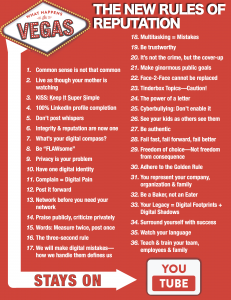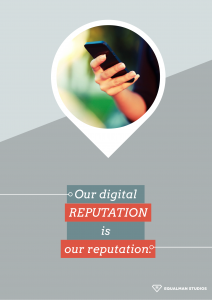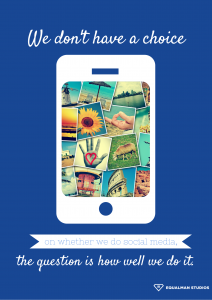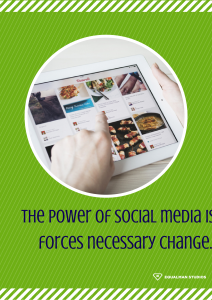Erik Qualman's Blog, page 601
May 15, 2014
Social Networking and Putting Babies Up for Adoption

 If you’re pregnant and considering giving your newborn up for adoption, social media can help guide you in the right adoption direction.
If you’re pregnant and considering giving your newborn up for adoption, social media can help guide you in the right adoption direction.
From chatting with other women in the same situation to seeking out words of advice from others who have been through the adoption process, social networking is an invaluable tool when it comes to connecting with others.
Here are just a number of ways social media can help you navigate the emotional waters of giving your baby up for adoption:
Socially Connecting With Expectant Mothers
Regardless of the reasons why you’re giving your baby up for adoption, connecting with other expectant mothers going through the same process is an important part of adoption. Contacting others who can share their emotions and give their support throughout the adoption process is mutually beneficial.
Whether you connect with a support group via Facebook or you follow Twitter feeds from adoption agencies, social sites can provide you with lifelong connections that will help you through your adoption journey.
And, anytime you need to speak your mind and see what others in your situation are going through, social media is always there.
Sharing Your Story with Others
Another great thing about social media is it gives you an opportunity to share your adoption story from your perspective.
Sharing your story with other expectant mothers who are considering adoption isn’t only therapeutic for you; it also helps your followers with their journey.
There are a number of ways to share your adoption story from posting updates on Facebook to adding a “This is my adoption story from my perspective” link to your various social accounts that redirects followers to your personal blog.
However you share your story, social media makes it possible to reach a wider audience and connect with others going through the adoption process.
Giving and Gaining Advice
If you’re considering giving your baby up for adoption, then you’re probably seeking advice from just about any source you can find.
Social media is a great resource for gathering advice on everything from finding the right adoption attorney to the proper steps to take after the birth to staying in contact with the adoptive parents.
On the flip side of the social coin, social networking also gives you the opportunity to give your advice to others based on your adoption experience.
First-hand advice is invaluably helpful for expectant mothers who are considering adoption and by using your various social circles, you can create an open forum for mothers looking for advice on the adoption process.
Following Adoptive Families
Depending on the type of agreement you make with the adoptive parents, social media is also the perfect way to stay in touch with the family that adopted your baby.
By connecting with the adoptive parents on social media, you can follow your baby’s journey through life via pictures, posts, and updates.
In addition, if you ever want to reconnect with your child a few years down the road and the adoptive parents allow it, social media is a great way to open a line of communication.
Even if it’s just sharing birthday wishes or accomplishments, social media can provide you with an ongoing relationship with your adopted child.
From advice sharing to sharing your story, social networking is a great tool to have throughout the adoption process.
Photo credit: theguardian.com
Thumbnail: http://tinyurl.com/nl9w67x
[image error]
May 12, 2014
Where Is The Enterprise Social Products Market Headed?

Earlier this week, Salesforce announced the launch of a new social platform for enterprises named “Social Studio”. Built on top of its previous acquisitions of Radian6 and BuddyMedia, the new social platform will help enterprise customer bring all their social media tools under one head. With this launch, Salesforce has pitted itself directly against Hootsuite which is the leader in the space with close to 8 million users.
Salesforce’s strategy over the past few years has mirrored the overall direction that enterprise social networking and management is taking. In the first half of the previous decade, social networking was purely focused at young consumers looking at conversing with friends and family. However, over the past five years, the use of social media by enterprises has risen by leaps and bounds. A study published by LinkedIn earlier this year revealed that nearly 81% of small and medium sized businesses today use social media to grow their business.
The use of social media is not just restricted in the area of customer relationship management. According to a study conducted by Microsoft last year, nearly 70% of employees use social media to communicate with their colleagues while over 50% use them for sharing and reviewing documents. This proliferation of social media and collaboration at the workplace presents a dynamic shift in the business mindset that traditionally viewed such tools as a workplace distraction. Today, it is being seen as a means to boost productivity and improve efficiency.
Consider cloud business and ERP software applications for instance. Traditionally, ERP solutions like NetSuite and SAP were meant to only handle resource and material planning in businesses. Today, their offerings are much more extensive with respect to social integration. For example, the features of NetSuite eCommerce cloud platform include integration with Fluid Social that enable customers to bring embedded chat, email and Facebook functionality within their applications. By opening up the platform to social tools, these software applications make it possible for businesses to engage with customers and execute their strategies in a more consumer-friendly model.
Despite the rapid growth in the use of social media and tools in enterprises, the industry is still in its infancy. There is still a lot of growth that could be expected in this space over the next decade. With the foray of social technology in areas such as customer satisfaction analysis, demand forecast and big data, the next generation of enterprise social tools will revolve around the use of analytic tools to interpret the data obtained from the engagement between enterprises and their consumers.
Photo Credit: aquopshilton
[image error]
Interesting Methods to Further Reviews for your Mobile Apps

Mobile apps are considerably popular in the present times. The reason can be attributed to the growing popularity of smart phones and the quick way apps give access to a lot of information and entertainment. As a brand or an organization, you need to establish your mobile presence which can be done only when you have created the perfect mobile app. Mobile app development is a major process which requires understanding of your target consumer’s needs as well as a user interface that is intuitive and interactive.
Your mobile app, once created enters the best seller category, only when your consumers who believe in you try to sell your app. Their reviews and opinions on your mobile app matters! You will find that consumers believe in word of mouth and reviews rather than what the brands boast of themselves. This is possibly why mobile app reviews are very important. Your work does not end with mobile app development; in fact it begins at this stage. You will need to give in some efforts to ensure that your mobile apps are being reviewed positively by the consumers of the app. Here are some of the tried and tested ways of getting your consumers to review about you.
App Review Plugin
This is a sure shot way of gaining some mobile app reviews from your faithful consumers. You will need to ask for the review. You will find that there are some amazing app review plugins available for both Android and iOS phones. Appirater is one of the most popular app review plugin meant for iOS phones. Within two minutes it places itself on your phone, and manages to curb reviews from your consumers for future. Make sure that the review popup does not come up too soon, else your reviewer might not want to review the app.
Incentives Work
Another best way to motivate people to review your app is to give out some incentives in return. Let’s assume you are a gaming app. You can always offer some points or coins that can be used against something if your gamers review the app. Similar things can be done for other apps too. The basic thing is that you will have to maintain a give and take situation here. While they are reviewing your app, you will need to provide them with some interesting rewards.
Feedback Reviews
Connect the feedback with the reviews. Let’s say you have a consumer support through a help desk online. So next time your consumer connects with you for some help, you should always provide them with excellent interaction and great one on one help. Once that is done, allow a feedback popup to be sent to the consumer. You will see that the consumer would want to fill out the feedback because of the excellent service. You can even associate app review with this feedback popup, and that excellent service will help boost the review.
Timed Popups
Timing is very important in every aspect of life. You should always remember that, and when you are asking for reviews timing plays an important role. You should make sure that your popup has been timed properly else you will not receive the perfect review. Don’t make the mistake of asking for a feedback as soon as your user launches the app. Make sure you don’t ask the user when he/she is in the midst of searching or something. You may ask when they are satisfied and about to leave or sometime mid way. App review timings are very important.
Review Contests
Contests with prize money associated to it are always a good idea to run review models. What you can do is ask your consumers to participate in the contest and write a review for your app. Consider giving out a good reward for those who participate and give out one of the best reviews possible for your app. This always works when you need some amazing reviews from your consumers.
Thumbnail: http://tinyurl.com/n4l9lum
[image error]
May 9, 2014
Business Communications: Use Your iPhone to Learn a Language

Employees who understand and speak more than one language can be an enormous asset in the current workplace. These individuals are highly sought, since they can communicate comfortably and efficiently in foreign markets, and assist a wider variety of customers.
According to research conducted by Korn/Ferry International, 31% of U.S. executives speak two languages. Business leaders around the world understand the value of being able to speak another language.
But attending classes and carrying a textbook can be costly and time consuming. Luckily, you can leverage your iPhone to help you master a new language.
Podcasts
If you’re an auditory learner, then Apple’s Podcast app offers a wealth of free audio to help you learn a foreign language. There are several tutorial podcasts for complete beginners, which help you tune your ear to the sound of a new language.
You might even find yourself repeating along with the instructors while you’re driving or taking public transit. The Podcast app has a helpful playback speed control feature, which gives you the power to slow down or speed up a podcast. This can be especially useful if you need to slow dialogue down to understand it.
Foreign language podcasts aren’t just for beginners, though. You can often find news podcasts and pop culture reviews in the language of your choice.
For example, the popular German news outlet, Deutsche Welle, uploads news and entertainment updates to the Podcast service for convenient listening. This makes the Podcast app a convenient learning resource for both beginners and seasoned speakers who want to brush up on a foreign language for business purposes.
Offline dictionary apps
Several companies offer dictionary apps with offline access. This is particularly useful during travel, when you may not have access to Wi-Fi or cellular data to look up definitions.
Some dictionary companies that include offline access include Ultralingua, dict.cc, Pocketglow, and Langenscheidt. These apps will take up extra space on your iPhone’s hard drive, so you can get access to word databases offline.
Since roaming fees can be costly during international travel, it’s wise to switch off your iPhone’s cellular data while you’re traveling. If you suddenly need to look up a word, these offline dictionary apps can help you translate without the hassle of roaming charges.
Google Translate
When you do have access to Wi-Fi or data, Google Translate can help you understand both text and audio that you don’t grasp. For example, if you don’t understand a word that someone has spoken, you can simply record the word with the mic tool and this app will quickly translate it.
The app can assist you in a conversation with another person, since you can both speak or type into the phone and have your text instantly converted.
International keyboards and language settings
It’s difficult to understand the full potential of your iPhone unless you’re practicing a new language. You can immerse yourself in another language by changing your default phone settings from English.
This shifts the entire iOS architecture into the language of your choosing, which will help you learn common tech terminology. Additionally, you can modify your international keyboard to let you cycle through dozens of language inputs, so you can type in Japanese kana, Russian Cyrillic, and many other alphabets.
Your iPhone can be an immense resource to help you master a new language. It can help you grasp the basics through podcasts, dictionaries, and keyboard input options.
In addition, you can use dictionary apps and Google Translate while abroad to get driving directions, order food, and conduct business. You’ll quickly find that your iPhone is indispensible when it comes to learning a new language!
[image error]
May 8, 2014
Powering the New Era of Loyalty: Brand Advocates


Photo: AP
Americans love loyalty. They’ll argue for hours about their Pepsi or Coke preference, show NFL tattoos off proudly in public and nearly 90% participate in some type of loyalty rewards program (BusinessWeek). But while loyalty is hardwired into our culture, when it comes to brand loyalty, the competition for consumers’ attention is fierce. With over 2.5 billion loyalty memberships in the U.S. (Colloquy), getting a slice of a potential or returning customer’s purchase consideration is a challenge. While most of these programs attach loyalty to repeat purchases, some brands are calling loyalty what it is: a human quality and emotion. This new wave of thinking is allowing brands to build on their relationships with their customers that not only drives purchase but also inspires advocacy.
The Digital Storefront
When a customer walks into a store, their experience will largely determine whether or not they make a purchase, return, or tell a friend about it (for better or worse). Excellent customer service leaves an impression on consumers because they feel that their personal needs are met and time is important. In the digital space, a brandss social media profiles become their brick and mortar shops – a place the customer can go to interact and have a brand experience. Here, an attentive brand has the ability to touch consumers every day with even the smallest action. A like on a Facebook post, a timely answer to a tweet, or offering an unsolicited thanks with a random surprise or reward can all help grow brand love, drive repeat engagement and eventually drive purchase. With brands beginning to reward behavior in customers’ daily and digital lives in addition to their purchases, the ground is shifting from driving loyalty to building advocacy. The more opportunities brands give their customers to earn rewards, the more rewarding data they will receive on their customers. The digital space is a great place to do exactly that.
Lancôme Offers Points For Social Media Engagement

Photo: Lancome-USA.com
In late April, Lancôme launched its Elite Rewards program. Customers enroll at no charge and earn points by buying products and engaging with Lancôme USA on its social media channels. Members earn points for the following interactions:
Up to 25 points for sharing products on Facebook, Instagram and Twitter
Up to 50 for connecting with the brand on Facebook, Instagram, Twitter and Foursquare
10 points for every dollar spent
Accrue points for watching makeup tutorials and other branded content online
Vice President of Lancôme digital marketing Alessio Rossi explained that, “Brands tend to look into how can I monetize this today. Instead, it’s about building a relationship with a human being. You don’t do it overnight. We had to take a longer horizon.” This model is one that will become more and more popular as brands turn interest into lifelong relationships with consumers instead of equating loyalty solely based on sales data.
Walgreens Rewards Wellness

Photo: Walgreens.com
Walgreens and Duane Reed have started offering non-transactional points through its Balance Rewards Program. In addition to purchases made in their stores and online, customers can earn points, badges and discounts in exchange for healthy behavior like working out, low cholesterol and immunizations. Participants connect the program with health and fitness apps like Jawbone and Fitbit to participate in these rewards and in return, their daily activity will incentivize them to spend their earned points in Walgreens or Duane Reed. In a market where 54% of loyalty memberships are inactive (almost all within the first year) (Colloquy), this keeps participants earning even when they aren’t shopping, which keeps Walgreens top of mind. The program leaves customers feeling like their pharmacy truly cares and gives the brands insight into who their customers are when they leave their stores.
As customers have higher expectations of brands looking to earn their loyalty, brands must make advocacy a higher priority. Customers enrolled in loyalty programs are great customers, visiting establishments 2 times more often and spending 4 times more (Deloitte).
For this reason, keeping them active is essential to growing a thriving business. It’s time brands stop looking at loyalty as an obstacle and start seeing it as an opportunity. Loyalty is a human quality and the more time a brand spends treating its customers that way, the more time those customers spend advocating for that brand.
[image error]
May 7, 2014
Securing Your Digital Presence in the Wake of the Heartbleed Bug

The digital world is still reeling from the Heartbleed Bug, which hit the wire in early April 2014. Many web services and firmware developers rushed to patch things up, but due to the nature of the bug, it is impossible to tell who exactly has been compromised. However, not every web service has completed their work on patching their operations against this bug, which means that many online users are still vulnerable. Heartbleedcheck.com is a fantastic tool for testing whether a particular website is vulnerable.
Finding Out What’s Safe
You’ll need to resort to some in-depth maneuvering on Google to really find out which services are completely safe. Some companies have details about the Heartbleed Bug emblazoned across their blog and home page, just so users know that they’re now patched and ready to receive your updated passwords.
However, there are many online services, hardware companies, and developers that aren’t making these updates very clear. For example, phone and router manufacturing companies like Cisco and Apple have information regarding Heartbleed that isn’t immediately apparent from their home pages. Rather, consumers must go digging press releases and security details to get the latest scoop on product updates regarding Heartbleed.
Tech publications like Mashable have been releasing updated lists that help readers quickly identify services that have been patched, so that you can proceed with updating your passwords. Bookmark one of these update lists and check in every week to see which services you can safely action on.
Get a Password Manager
Unfortunately, since many service are still up in the air, it sounds like we’ll be cycling through new passwords for quite some time. This can lead to major confusion whenever you log onto a web service. Did you change your password yet? Or was it the other new one? Instead of trying to manage your countless passcodes in your mind, software like OnePassword or LastPass can keep track of it for you.
Not only do these solutions hang onto your passwords, they can also generate super secure passwords for you. These include combinations of numbers, words, and character that are unlikely to be guessed by hackers and their password breaking software. These secure codes can be simply copied and pasted from your password manager into a login screen. It can be argued that random password generators are more secure, because they use words and phrases that don’t have personal relevance in your life. Birthdays, locations, pet names, and other personal data can help hackers socially engineer your passwords.
Watch the News
It’ll be an annoyance, but web users should continue to keep an eye out for continued Heartbeat coverage. Since so much is unknown regarding the repercussions of this bug, it is likely that major updates regarding affected systems will continues to appear in the news. You might want to consider adding a Heartbleed category to your RSS feed software or creating a Google News alert for relevant articles, which can be forwarded to your email inbox.
It can be impossible to monitor individual company websites for updates regarding their own services. Luckily, most companies are emailing their customers with relevant update information, so be sure to keep an eye out on your inbox and take action whenever needed.
Remain Diligent
Heartbleed gave Internet users a very sobering reminder of the potential risks. So much of our lives are governed by online services and networking hardware. If you haven’t already been taking password security seriously, now is the time to start. Don’t let your passwords stagnate, and don’t use the same words and phrases over and over. Hackers are banking on poor security hygiene and looking for easy marks to take advantage of. Don’t just hand these threats the keys to your life. Additionally, you need to check the SSL certificates of the websites you’re visiting, so that you don’t accidentally provide your user name and password to a hacker posing as a legitimate company.
It is likely that web threats like Heartbleed will become an occasional occurrence as security experts discover and protect us against new breaches in systems that we all rely on. You can use password managers to make sense of the chaos. Business owners and online retailers can protect their digital audiences by using secure web hosting with site authentication and newer security features like SiteLock, which automatically scans websites for malware and other vulnerabilities.
Essentially, web audiences should be able to verify the identity of the websites they are visiting. The main steps you can take right now to combat these risks are to remain aware of web service updates, keep an eye on the news, check website authentication certificates, and action on password changes immediately.
[image error]
Facebook’s Anonymous Login: Great for Users, Okay for Marketers

Tired of offering something for nothing, Facebook has waved its magic wand once again and made a change that, for once, privacy advocates might applaud. The company will now allow users to log in anonymously through third-party sites, instead of sharing all the information that they make available on Facebook.
So, for instance, if someone uses their Facebook profile to log in to a workout site like Daily Mile or a news site such as The Washington Post, they won’t have to share everything about themselves. Facebook will basically be their virtual passport, and they can use the service or website they’ve logged into without leaving behind their personal information.
This idea will be terrific for users, but marketers may have some initial qualms, since the information they’re privy to is limited. Here’s how it’s expected to play out.
Why Users Will Love It
Let’s face it, privacy advocates aren’t Facebook’s biggest fan. They object to the social network sharing information with advertisers that many people aren’t even aware they’ve consented to. Even photos from private Facebook accounts can be incorporated into ads without the user’s express consent; instead, the social network uses a blanket form to get permission for everything.
But the anonymous log in puts the power back into the consumers’ court. They can limit the information they’re exposing to marketers while also saving time by using Facebook to gain entry to a site rather than going through a cumbersome sign-up process.
What’s in it for Facebook?

Mark Zuckerburg at the F8 Conference, via Time
Now you know that Facebook isn’t making these changes out of the goodness of its heart or a sudden concern for users’ privacy. It’s motivated by two things: money and influence. Money, because it has access to a whole bunch of demographic information that marketers are itching to get their hands on but that has suddenly become its private domain. And influence because, at a time when people are spending less time and getting more frustrated with Facebook, the site is changing its focus.
Even if people don’t want to go spend zillions of hours on Facebook anymore, they can still use it as the aforementioned virtual passport, saving them valuable time logging onto sites. Instead of filling out form after form to access news or activity sites, they can log on with Facebook in the blink of an eye. That keeps the site relevant, and it’s actually pretty brilliant.
Why Marketers Will Learn to Like It
Of course, the loser in this scenario would appear to be marketers. They no longer get a full sign-up from users, and they don’t have the access to Facebook profiles that they previously enjoyed. That’s a big disadvantage.
But Facebook knows what marketers want, and it is pledging to work with them to provide it. The truth is, a site may get an unexpected number of benefits from the new program. Let’s consider an example. Memolink, a free online rewards site, allows users to join by either filling out a form manually or logging in with their Facebook account. In the short term, the lack of information about those signing up could certainly hinder Memolink’s targeting efforts. But in the long term, it will undoubtedly get more sign-ups because users will appreciate the ability to control what information is being shared about them; that means more users to reach out to and leverage.
Protecting Your Privacy
Facebook was smart to rejigger its offerings at a time when the web is pushing ever more toward privacy in the wake of troubling security breaches such as Heartbleed. In the end, both users and marketers will benefit from these changes, and Facebook will achieve its ultimate goal: remaining ubiquitous.
Images: Pixabay | Wikipedia | Time
[image error]
May 5, 2014
Free Printables: 4 Social Media Posters for Your Office

Need some inspiration? These printable posters are perfect to hang up in your office, classroom, or home.
Download the ‘New Rules for Reputation’ Poster
Download the Social Media Quote Posters (3)
[image error]
How to Clean Up Your Social Media Channels

It’s easy to collect a lot of junk on your social media accounts, especially if you’ve jumped on every platform that’s been created. However, when it comes to spring cleaning, why not take a closer look at those photo albums from five years ago, comments that might put you in the hot seat with your boss, and start sifting through those friend lists? Start by taking a look at who has access to your information, and remember that all of these people (depending on your settings) are getting a front row seat to your life. Few people are actually close to hundreds of people, and it might be time to trim the fat.
You can get this process started by considering who you think of when you imagine your feed or timeline. Is there someone who’s constantly ranting, posting about hot button topics, or otherwise makes your social media experience anything but good? You may not realize it, but you’ll be directly impacted for the day (if not longer) for something as seemingly harmless as a political infographic. Take back control of your social media; hide or unfriend these instigators.
Skip the Kool Aid
Are you being bombarded with ads, especially on Facebook? If you want something, you probably already know the best sites on which to shop for it yourself, and you don’t need an ad for the same yoga pants you just bought (nobody ever said Facebook ads were perfect). Shopify and similar POS systems have made it easy for anyone to set up shop online; you don’t need to be bombarded with ads telling you which one to shop from! Simply select the arrow next to the ad to keep it hidden for good. While this won’t stop all ads from cropping up, at least you can cherry pick what you don’t want to see.
At the same time, take a closer look at all those groups you’ve joined. Even if they don’t post daily, it’s another way to clean up and move on with your life. You may not even remember joining that gaming group or the one to vote for whoever in 2012. However, the groups you’re in are one of the most easily accessible pieces of information for Facebook lurkers, and you don’t want a reputation built on forgotten groups.
Regain control
You probably get notified on your mobile device when someone tags you in a photo or posts on your timeline, and then forget about it. It’ll take some time, but try going through all those past posts and cleaning up anything you don’t want public. To prevent these things from happening in the future, adjust your settings in Tagging to control who can add things to your timeline. Up the security by only allowing friends to see your tagged posts by limiting past posts, and opt to review anything you’re tagged in.
Head on over to Twitter next to manage your lists. You probably follow a number of people, meaning your tweets are too many to actually read. Making lists is easier than unfollowing people, plus you avoid the chance of hurting any feelings. Sort by whatever you like, from news to travel, and make sure that master list has all the juicy people you follow whether it’s a Kardashian or a politico. Spring cleaning doesn’t have to have tangible results, and there’s no reason you can’t clean up while nestled in your snuggie on the couch.
[image error]
How to Respond to a Social Media Crisis

While not every social media marketer is going to experience a lot of success with their brand, most are going to eventually experience a crisis. Social media crises happen quickly and with frightening regularity, from a couple of spammers bombing your page to a negative trend that’s causing your sales numbers to plummet severely.
There are many steps you can take in order to avoid such a crisis, but even the most proactive people in the world still have to find that they’re reactive at times. Think of it like living in a hurricane zone. Sure, stronger structures are a must, so there’s a lot to be said for proactive precautions. However, another hurricane is still going to blow in, despite your best efforts. So how are you going to handle it?
Here are some tips to help you weather that proverbial storm.
Tips for Quickly and Effectively Handling a Crisis in Social Media
1: Have a Reputation to Fall Back On
The first tip discussed here deals with how being proactive can help you eliminate some of the reactive steps you would otherwise have to take. To put it another way, having a solid online reputation may cause some people to look past the faults and at the positive aspects of your brand.
Do you remember when McDonald’s was dealing with controversy a few years back due to some managers influencing employee votes for elections? Yeah; few remember it, and that’s because the brand has a solid reputation that acts like oily glass when controversy tries to stick to it. So the stronger you can build up your positive reputation, the better you’ll be at handling any crisis.
2: Never Neglect the Situation
Now it’s time to get into the actual particulars of what to do when a crisis rears its head. The first thing to remember: Never ignore the situation! Even if you think it’s only a troll trying to wreak havoc on one of your social media pages, you need to step into action. Don’t feed the thing; that’s only going to make it stronger. Just step in and shut it down, preparing for damage control.
The same holds true with any type of crisis. You need to pay attention to it. A pesky mole on your arm can unfortunately be a sign of something a lot more serious. Think of a crisis the same way. Even something that seems minor can become major if neglected.
3: Build Up a Strong System
One of the best ways to handle every situation is to have a system in place for dealing with certain crises in social media. This isn’t to say that you need an entire department dedicated to dealing with PR. However, you still need to direct the negativity away from the rest of your brand. You want to segment things off when a crisis appears.
Having a thorough FAQ section may help solve someone’s angst before they take it out in profanity-laced comments. Having a support system may quell the frustration before it boils over. Having a separate email or area to deal with angry fans/customers will help to direct the crisis away from the rest of your brand. Do you see what we’re getting at here? It’s about creating a firewall around the perception of your brand. If a crisis appears, you can direct it to another channel that’s outside of the public eye.
4: Act ASAP
No matter what type of crisis it is, your quick action is required. Stepping in to act quickly grants you a few benefits. First and foremost, you can quarantine it before it spreads. Secondly, you might be able to nip it in the bud. Most importantly, however, acting quickly gives you ample time to deal with the crisis at hand.
Rather than catching it late after it’s already grown and spread, getting it in its infancy opens many more doors and allows you to think of a working solution. And as vague as that may sound, it’s important to understand that every crisis is different. Catching it early allows you to troubleshoot issues and to implement different solutions depending on the particular crisis.
5: Put a Happy Face on It
One of the best things you can do with any social media crisis is to put a happy face on it. This is when the PR comes into play. For instance, if your particular crisis is a couple of angry customers who are plastering your social pages with messages about how badly your brand sucks or how misleading the description is, step in and speak to these people directly and offer them something to atone.
Even if it’s not your fault and what you’re dealing with are a few knuckleheads who threaten to spoil the entire barrel with their bad apple status, soothing this particular beast will help to prevent the spread of the crisis. People who don’t know your brand from Adam will jump aboard a sinking ship just to poke more holes in it; that’s just how the Internet works. So if you can slap a happy face on something, bite that bullet and do it.
6: Be Opportunistic (Or Ready to Move)
There are two main options you have available to you after a crisis, with the former before far more important to your brand than the latter. Be opportunistic about the crisis, or simply move on. For instance, you can use a solved crisis to your benefit. You can showcase to your existing fanbase how you quickly and effectively handled a crisis and how you satisfied disgruntled customers.
Though if you can’t find any opportunity to work to your advantage with the crisis, then you must simply move on from it. Don’t bring it up; don’t waste your time sending out apology messages to everyone. If you can’t spin it in your favor—and provided that the crisis has been quelled—move on like it never happened.
Every brand is most likely going to experience some sort of crisis. How you handle it says a lot about your business aptitude and your willingness to compete in today’s social media market. Work constantly to keep a great reputation, and always remember to handle crises quickly by segmented them off, working some PR, and trying to spin them into gold.
Image Credit:
https://www.flickr.com/photos/mkhmark...
[image error]









